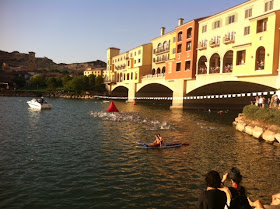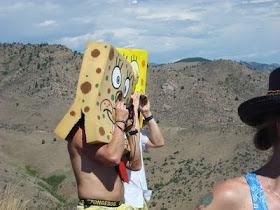For the past few years the Texas State Championship has been held at Ford Hood, a military base that provides a course completely closed to traffic. Negotiating this race location is not always easy, as security measures are very strict, but the payoff is huge. A closed course means no center-line rule is required, which improves safety and also prevents many controversial penalties. Additionally, the race raises money for the Association of the United States Army.
The course at Fort Davis is a 33-mile loop, which is traversed between 1 and 3 times depending on the race category. It is among the hillier routes in the area, which makes for tough, exciting races.
Women's Cat 1/2, and Cat 3 Races
As often happens in women's racing, due to low numbers, the Cat 3 women were started along with the Cat 1/2 race (though the races were still scored separately). This has the downside of suddenly changing the tactics and nature of the race. On the bright side, it means that a handful of women don't have to suffer through 66 miles by themselves. The only perfect solution to this dilemma, of course, is to get more women out there racing next time. And there's plenty of incentive, ladies! Money and fame to be won, beautiful pictures to be had, great scenery, a killer workout, drama, glory, and pain! What more could you want?
Another surprise was in store – pro triathlete stud Desiree Ficker was in attendance for the Cat 3 race. She would certainly be an outlier in power production for the category, so the other girls would need to be clever to get to the finish ahead of her. What they did not know, was that Desiree had run in a 16-mile running race that morning, and won it!
The 1/2/3 race was 66 miles, two laps of the hilly Fort Hood course. The temperatures were already over 100 degrees, with no shade available to escape the heat of the sun. One would think this would cause the race to start conservative and slow, but Lauren Robertson and Kaelly Simpson of the Metro Volkswagen Cycling Team had other plans. From the gun the two were taking turns launching attacks up nearly every hill on the course. Power file data from the race shows sustained 500+ watt efforts with peaks over 800 watts just to hang on to the lead pack on the first lap!
The aggressive tactics of the Dallas Metro team shelled almost the entire race off the back. Eventually only Sheri Rothe of the Austin Flyers, Kat Hunter of Austin Tri-Cyclist Women's Racing, Desiree Ficker, and the two Metro girls remained, with a $100 prime awaiting at the end of the first lap. When they neared the line, Lauren pulled up in front of her teammate, perhaps to help lead her out, but Kat pulled to the left (the wrong side it turns out, as it was windward) and shot ahead to take the Cat 3 prime, while Lauren collected the Cat 1 prime ahead of Sheri. The girls all grabbed a bottle or two in the feed zone, staffed by an enthusiastic crew from Comanche Racing, but it would not be enough water to deal with the extreme heat.
If the story of lap 1 was huge attacks, the story of lap 2 was surely unexploded bombs and cyclocross racing! The power peaks were down this lap but the drama surely was not. In the middle of lap 2, the leading women encountered a military police officer who told them they could not continue down the road. An "unexploded ordnance" had been sighted near the race course by one of the police officers manning the corner. The whole race stopped there for a moment as the lead car negotiated with the MP. The options were to turn around (confusing given that the rest of the field behind were able to use both lanes of the road) or take a dirt road detour around the danger radius. The lead women were starting to get anxious at the delay, worried that they would lose their lead. The women made the call to head down what was referred to as the "tank road," about a mile of dirt and rocks. No doubt many racers had picked their lightest, most aerodynamic wheels, and most supple, fast tires for this big race. Fortunately everyone made it through the dirt without incident. Nobody fell, nobody flatted, and nobody was exploded by any bombs at all.
Back at the finish line, spectators were hearing the news about the bombs, and military helicopters were flying overhead. Like typical bike racers, most of us were more concerned about the race being interrupted than anyone's safety. Everyone was relieved to hear that the lead pack had made it through. We began congregating at the finish line where we would pick up bits of news overheard from the officials race radio. At one point, we heard, "We need two Gatorades at the Iraqi Village ASAP!" News trickled in that it was Desiree Ficker, who was now on the way back in one of the race vehicles, suffering from severe dehydration and/or heat stroke. We also learned that Sheri Rothe had lost contact with the lead group, leaving only Kat (Cat 3), Kaelly (Cat 3), and Lauren (Cat 1) at the front. Lauren now had her own victory all but assured, and she was working hard to get her teammate a win as well.
Finally, in the distance we saw the three girls approaching. Lauren went to the front, setting a strong pace to lead out her teammate, with Kat having to hold 250 watts in the draft for a minute and half to stay on the train. Around the 200m sign, Kat moved left and threw down a 650-watt surge to come around the Metro girls and get the Cat 3 win, just a few bike lengths ahead of Kaelly. Lauren eased up, a hard day's work completed, the new Cat 1/2 State Champ, and well deserved!
Men's P/1
On the men's side a small breakaway group survived to the end, consisting of Stefan Rothe, Logan Hutchings, Gray Skinner, and Brant Speed. Logan Hutchings would be first across the line, but not being a permanent resident was not eligible for the award of Texas State Champion, which went to Stefan Rothe. Brant Speed followed in 2nd place with Gray Skinner in 3rd for Team Austinbikes, making for a complete podium sweep by the city of Austin!
Other exciting news
The men's 4 race was won in dominant fashion by Kevin Girkins of Team Concept Racing. However, as he crossed the line he was so excited with his performance he let loose a primal scream which included a four letter word – right in front of the officials. Profanity is against USAC rules and the officials decided that the punishment would be relegating Kevin to 6th place. Let the record reflect, however, that while Kevin's situational awareness needs development, he crushed that race, and won it. Kevin has since apologized publicly and accepted his relegation with class. Good work Kevin, you will be back!
Sir Christoph Trickey of Team Wooly Mammoth recovered from a tough day in the Cat 2 race on Saturday by consuming two beers, and returned on Sunday to take 2nd in the 35-39 age-based championship.
Newcomer Ash Duban, sporting the Desiree Ficker kit she designed, fought off an aggressive ATC Women's team to win the Women's Cat 4 championship for Comanche Racing. The ATC women were all present at the front of the race, taking 3rd, 4th, 6th, and 7th place in their first season racing together.
Links and Info
- Go to Lee McDaniel Photography for more great race photos.
- The Racing Post has more details on the race, venue, and military contributions.
- Official results up at TXBRA.org
Thank you to Fort Hood, Copperas Cove, and everyone who helped make the race happen!





















